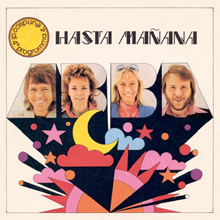Loading AI tools
1974 single by ABBA From Wikipedia, the free encyclopedia
"Hasta Mañana" (Spanish for "Until tomorrow" or "see you tomorrow") is the fourth track on Swedish pop group ABBA's second studio album, Waterloo. It was released in 1974 as the album's third and final single.
This article needs additional citations for verification. (December 2009) |
| "Hasta Mañana" | ||||
|---|---|---|---|---|
 Italian pressing | ||||
| Single by ABBA | ||||
| from the album Waterloo | ||||
| A-side | "Honey, Honey" (Netherlands, Spain) | |||
| B-side | "Watch Out" (Italy, South Africa) | |||
| Released | 1974 | |||
| Recorded | December 18, 1973 | |||
| Studio | Metronome, Stockholm, Sweden | |||
| Genre | Pop, Europop | |||
| Length | 3:09 | |||
| Songwriter(s) | Benny Andersson, Björn Ulvaeus, Stig Anderson | |||
| Producer(s) | Benny Andersson, Björn Ulvaeus | |||
| ABBA singles chronology | ||||
| ||||
| Audio | ||||
| "Hasta Manana" on YouTube | ||||
Initially fearing that "Waterloo" might be too risky to enter for the 1974 Eurovision Song Contest, the group considered performing the ballad "Hasta Mañana" instead, as they thought that it was more in style with previous Eurovision winners. Eventually, they decided on "Waterloo", primarily because it featured Agnetha Fältskog and Anni-Frid Lyngstad sharing lead vocals, whereas "Hasta Mañana" had Fältskog as the sole lead vocalist. ABBA believed that this would give the wrong impression of them to the world.[citation needed]
The song was still known under its original working title "Who's Gonna Love You?" when the backing track was recorded.[1] The lyrics were later written by Stig Anderson while on a Christmas holiday to the Canary Islands and dictated over the telephone.[1]
While the song was being recorded, they decided to give up on it at one point because none of them could sing it properly. Agnetha alone was in the studio and decided to play around with it. She felt that if she could sing it in a Connie Francis style it would work — and it did.[2][1]
In Australia, "Hasta Mañana" was used as a B-side on the "So Long" single (which never charted). After being featured in the popular The Best of ABBA TV Special, broadcast in March 1976, the song was re-released and became a Top 20 hit in Australia and Top 10 hit in New Zealand.
It reached number 2 on the charts in South Africa in November 1974.[3]
| Chart (1974) | Peak position |
|---|---|
| Italy (Musica e dischi)[4] | 28 |
| South Africa (Springbok Radio)[5] | 2 |
| Chart (1976) | Peak position |
|---|---|
| Australia (Kent Music Report)[6] | 16 |
| New Zealand (Recorded Music NZ)[7] | 9 |
| Chart (1977) | Peak position |
|---|---|
| Canada Adult Contemporary (RPM)[9] | 37 |
| US Easy Listening (Billboard) | 32 |
Seamless Wikipedia browsing. On steroids.
Every time you click a link to Wikipedia, Wiktionary or Wikiquote in your browser's search results, it will show the modern Wikiwand interface.
Wikiwand extension is a five stars, simple, with minimum permission required to keep your browsing private, safe and transparent.